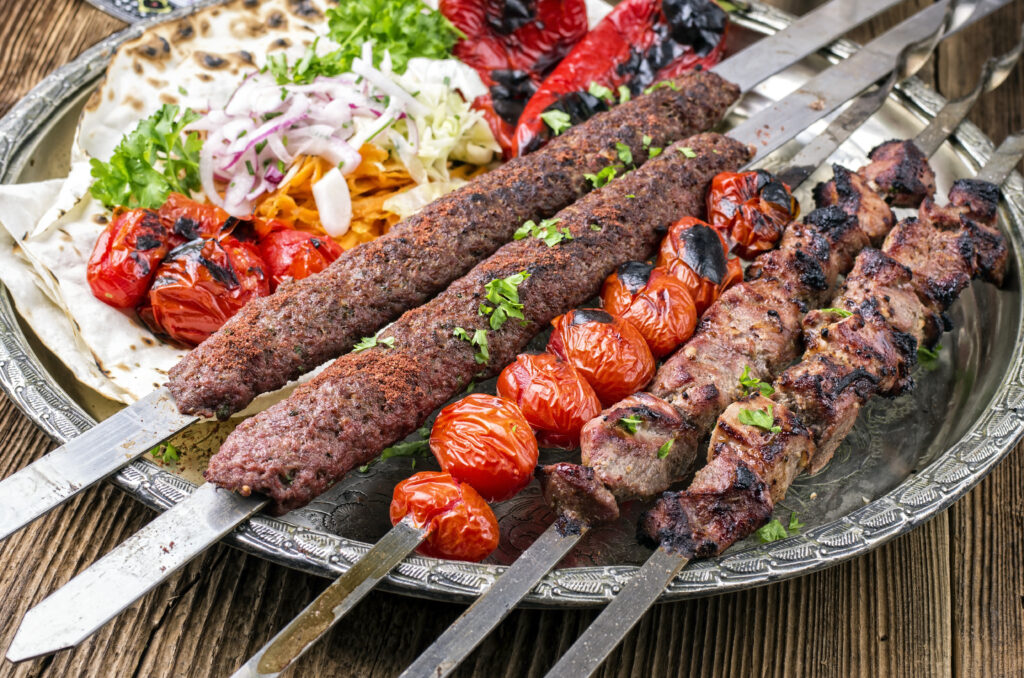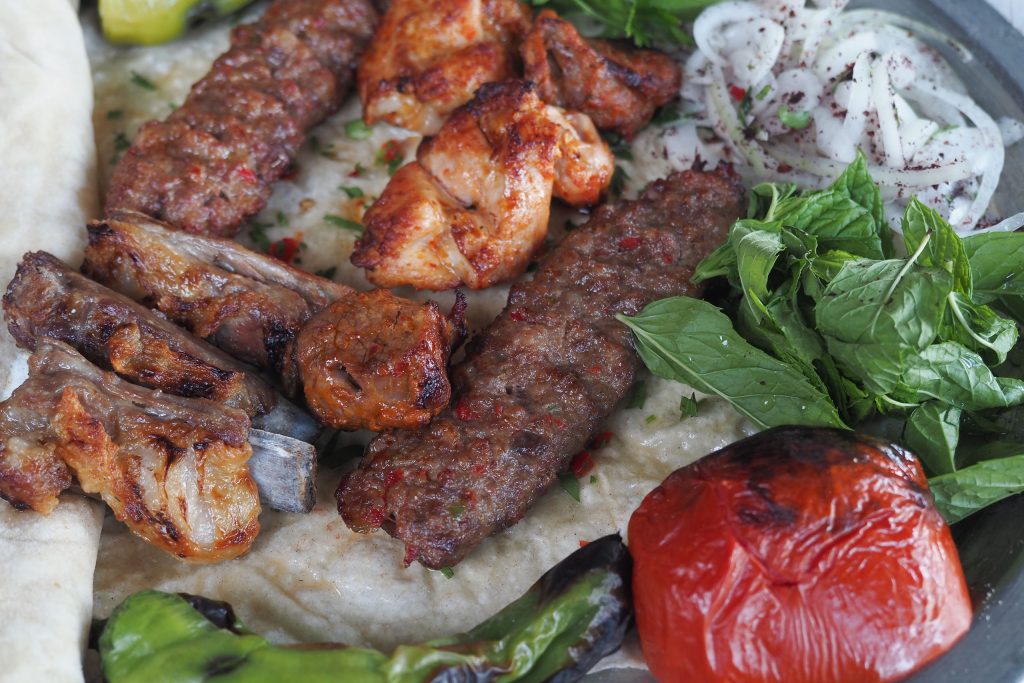
Kababs are more than just a popular dish; they are a culinary journey through history and culture.
This beloved dish, known for its rich flavors and various cooking styles, has roots that span across continents and civilizations, making it a staple in cuisines around the globe. From the bustling streets of Istanbul to the aromatic kitchens of Aleppo and the spice-laden markets of Kabul, kababs are celebrated for their unique regional twists.
Origins of Kabab
The history of kabab dates back to ancient times, with evidence suggesting its presence in various forms in Middle Eastern and South Asian cultures. Originally, the term “kabab” referred to the technique of grilling meat over an open flame. Historians believe that the dish spread across the Middle East and South Asia through the medieval trade routes, where it was adapted to local tastes and ingredients, thus giving birth to numerous variations.

Did you know?
While many associate kababs with Middle Eastern cuisine, the concept of cooking meat on a skewer is ancient and has been traced back to the prehistoric times. Evidence suggests that early humans used the technique as an efficient way to roast meat over an open fire using wooden sticks. This method spread across civilizations from the Greeks to the Mongols, who each added their own spices and cooking styles to evolve the kabab into the diverse forms we enjoy today.
Turkish Kababs: A Taste of Tradition
Turkish kababs are renowned for their simplicity and emphasis on the quality of the meat. In Turkey, kababs often feature cuts of beef or lamb, marinated in a mixture of oil, onions, and mild spices, then grilled to perfection. What sets Turkish kababs apart is their focus on the natural flavors of the meat, often enhanced with a bit of sumac or other subtle seasonings, rather than heavy marinades. The popularity of dishes like Adana and Urfa kababs in Turkish cuisine showcases the perfect blend of minimalistic seasoning and charcoal-grilled mastery.
Another highlight from our menu is the Adana Kabab, which showcases the Turkish approach to kababs. This dish is named after the famous city of Adana in Turkey and is known for its hand-minced meat mixed with vibrant spices then mounted on a wide iron skewer and grilled over charcoal. The spices blend seamlessly with the juicy meat, creating a flavor that is both bold and refined. The simplicity of the spices and the cooking method allows the natural flavors of the meat to shine through, making it a favorite among those who appreciate the art of Turkish grilling.
Middle Eastern Kababs: A Symphony of Spices
In contrast to the Turkish style, Middle Eastern kababs often incorporate a richer palette of spices and herbs. Countries like Syria, Lebanon, and Iran have developed their own versions of kababs, each with unique ingredients that reflect their culinary culture. The Syrian city of Aleppo, for example, is famous for its kababs, especially the versions that include eggplant slices or pistachios. Aleppo kababs with eggplant, known as Kabab Hindi, involve alternating pieces of meat and eggplant on the skewer, adding a delightful texture and smoky flavor. Meanwhile, pistachio-studded kababs offer a crunchy, nutty contrast to the tender meat, making them a festive favorite.
Exploring the different styles and flavors of kababs at Ottawa Kabab gives patrons a unique opportunity to taste authentic variations of this classic dish. For example, our menu features the Aleppo Kabab, a specialty that uses the traditional Syrian method of including pistachios in the mix, offering a crunchy texture that contrasts beautifully with the soft, spiced meat. The Aleppo style is also celebrated through our Eggplant Kabab, where slices of smoky grilled eggplant are alternated with spiced meat on the skewer, infusing the kabab with additional moisture and flavor that captivates the palate.
Afghani Kababs: The Spice-Infused Delights
Afghani kababs stand out due to their liberal use of spices. Unlike the milder Turkish kababs, Afghan cuisine prefers a bold approach, incorporating spices such as cumin, coriander, and turmeric into the marinades. This results in kababs that are not only flavorful but also have a distinctive aroma. The use of lamb, beef, and chicken, marinated in rich spices and then grilled over coal, produces a succulent dish that is both hearty and warming.
Our menu also includes the Afghani Chicken Kabab, which is marinated in a mixture of garlic, herbs, and spices typical of Afghan cuisine, then grilled to perfection. This dish represents the essence of Afghan kababs, known for their rich marinades and robust flavors that resonate with the use of traditional spices like cumin and coriander. Each bite delivers a burst of flavors, making it a popular choice for those looking to explore the heartier side of kabab varieties. Whether you’re a fan of the delicate Turkish flavors or the spice-infused Afghan style, Ottawa Kabab offers a diverse range that caters to all tastes and preferences, ensuring every visit is a delightful culinary adventure.
Did you know?
In the West, kababs are commonly made with lamb, beef, or chicken. However, in countries like India and parts of the Middle East, kababs are also frequently made with fish, and even camel meat. Each type of meat offers a different flavor and texture, showcasing the adaptability of kabab recipes to local tastes and available ingredients.

Cultural Significance and Modern Adaptations
Kababs are more than just food; they are a cultural symbol, representing the communal and celebratory spirit of the regions they come from. Today, as kababs continue to travel and evolve, they are embraced in urban eateries and fine dining establishments worldwide, adapting to contemporary tastes while retaining their historical essence.
At Ottawa Kabab, we pride ourselves on bringing authentic kabab experiences to your plate, celebrating the rich history and diverse styles of this ancient dish. Whether you’re craving the subtle elegance of a Turkish kabab, the aromatic richness of a Middle Eastern style, or the bold flavors of an Afghani skewer, our grill menu is designed to transport your senses to the very regions these dishes hail from.
Kababs continue to capture the hearts and palates of food lovers everywhere, proving that this age-old dish is truly timeless. So, the next time you bite into a skewer of expertly grilled kabab, remember, you’re not just enjoying a meal; you’re partaking in a piece of culinary history.
Did you know?
In some cultures, kababs are not just food; they carry symbolic meanings and are part of rituals and celebrations. For instance, in Iran, kababs are traditionally served to honor guests, reflecting a sign of respect and hospitality. During certain festivals and communal gatherings, specific types of kababs are prepared to celebrate the occasion, making them integral to cultural expressions and communal identity.
Is it “Kabab” or “Kebab”?
The terms “kabab” and “kebab” are essentially variations of the same word, used interchangeably to describe a popular dish made primarily of skewered and grilled meats. The difference in spelling largely depends on regional language variations and transliterations from different alphabets to the Latin alphabet, which is used in English.
- Kabab: This spelling is commonly used in parts of the Middle East, South Asia, and within various diaspora communities from these regions. It derives from the Arabic and Persian word “kabāb,” which is believed to have possibly originated from Aramaic.
- Kebab: More commonly used in Western countries and regions influenced by Turkish culture. The term “kebab” is prevalent in Turkey and has become the more familiar term in many parts of Europe and the Americas. It’s the Turkish spelling for the same type of dish and is widely adopted in English-speaking countries.
In conclusion
Kababs are not just a culinary delight but a journey through history, culture, and tradition. This dish, beloved for its diverse flavors and cooking styles, reflects the rich heritage of the regions it hails from, with roots stretching across continents and civilizations. From the simple yet flavorful Turkish kababs to the spice-laden Afghani variations, each style tells a story of the people and places that shaped it.
At Ottawa Kabab, we honor this legacy by bringing authentic kabab experiences to our patrons, offering a menu that showcases the rich diversity of this ancient dish. Whether you prefer the subtlety of Turkish grilling or the bold flavors of Middle Eastern and Afghan spices, our kababs promise to transport your taste buds on a global culinary adventure.
So, the next time you enjoy a skewer of kabab, remember that you’re not just savoring a meal—you’re partaking in a tradition that has connected people across cultures and centuries, proving that the kabab is indeed a timeless treasure of world cuisine.
